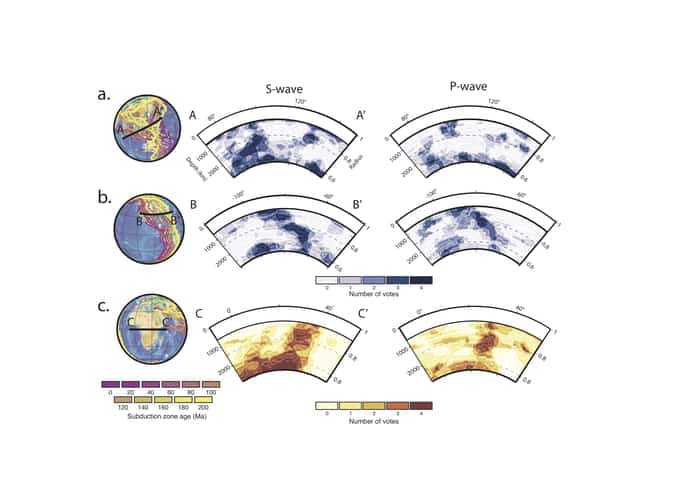This interdisciplinary study confirms predictions made by Wentzcovitch and group members in 2014 that lateral temperature variations in the lower mantle produce an anti-correlation between bulk and shear velocities owing to the spin crossover in iron in ferropericlase. This effect provides an interpretation for previously mysterious observations in seismic tomography maps.
Shephard, G.E., Houser, C.,et al., Wentzcovitch, R.M., Seismological expression of the iron spin crossover in ferropericlase in the Earth’s lower mantle. Nat Commun 12, 5905 (2021). https://doi.org/10.1038/s41467-021-26115-z
Press Highlights
Quantum phase transition detected deep inside the Earth by physicsworld, IOP Publishing
Researchers have identified a quantum phase transition taking place in iron more than 1000 kilometres deep within the Earth’s mantle. This transition, known as a spin crossover, also occurs in nanomaterials used for recording information magnetically, meaning that the effect stretches from the macro- to the nanoscale.
Cold, subducting oceanic plates are seen as fast velocity regions in (a) and (b), and warm rising mantle rock is seen as slow velocity regions in (c). Plates and plumes produce a coherent tomographic signal in S-wave models, but the signal partially disappears in P-wave models. (Courtesy: Columbia Engineering)
Quantum phase transition detected on a global scale deep inside the earth by EurekAlert, AAAS
In 2006, Columbia Engineering Professor Renata Wentzcovitch published her first paper on ferropericlase, providing a theory for the spin crossover in this mineral. Her theory suggested it happened across a thousand kilometers in the lower mantle. Since then, Wentzcovitch, who is a professor in the applied physics and applied mathematics department, earth and environmental sciences, and Lamont-Doherty Earth Observatory at Columbia University, has published 13 papers with her group on this topic, investigating velocities in every possible situation of the spin crossover in ferropericlase and bridgmanite, and predicting properties of these minerals throughout this crossover. In 2014, Wenzcovitch, whose research focuses on computational quantum mechanical studies of materials at extreme conditions, in particular planetary materials predicted how this spin change phenomenon could be detected in seismic tomographic images, but seismologists still could not see it.
Click to extend...
Working with a multidisciplinary team from Columbia Engineering, the University of Oslo, the Tokyo Institute of Technology, and Intel Co., Wenzcovitch’s latest paper details how they have now identified the ferropericlase spin crossover signal, a quantum phase transition deep within the Earth’s lower mantle. This was achieved by looking at specific regions in the Earth’s mantle where ferropericlase is expected to be abundant. The study was published October 8, 2021, in Nature Communications.
“This exciting finding, which confirms my earlier predictions, illustrates the importance of materials physicists and geophysicists working together to learn more about what’s going on deep within the Earth,” said Wentzcovitch.
Spin transition is commonly used in materials like those used for magnetic recording. If you stretch or compress just a few nanometer-thick layers of a magnetic material, you can change the layer's magnetic properties and improve the medium recording properties. Wentzcovitch’s new study shows that the same phenomenon happens across thousands of kilometers in the Earth’s interior, taking this from the nano- to the macro-scale.
“Moreover, geodynamic simulations have shown that the spin crossover invigorates convection in the Earth’s mantle and tectonic plate motion. So we think that this quantum phenomenon also increases the frequency of tectonic events such as earthquakes and volcanic eruptions,” Wentzcovitch notes.
How Can Quantum Mechanics Help Researchers Understand the Deep Earth? by Columbia Quantum Initiative News
Our planet is full of mysteries. How exactly did Earth form and evolve to its current state? Why do some places in its interior seem hotter or colder, rising or sinking? For answers, geoscientists experiment on materials expected to be found in Earth’s interior, but these exist at immense pressures and temperatures that are impractical to reproduce in the lab. Renata Wentzcovitch, a condensed matter physicist, says quantum simulations can help.
“Nature is quantum,” said Wentzcovitch, a professor at Columbia Engineering and the Lamont Doherty Earth Observatory.
Quantum Phase Transition Detected on a Global Scale Deep Inside the Earth by Columbia SEAS
Quantum Phase Transition Is Detected on a Global Scale in the Deep Earth by State of the Planet, Columbia Climate School
Science Highlights
A mantle spin transition by Brent Grocholski
Ferropericlase, one of the primary mantle minerals, is known to have an electronic spin transition. However, evidence of this transition in the Earth’s mantle has been challenging to find. Shephard et al. found changes in seismic wave speeds at two depth ranges that correspond to the iron spin transition in ferropericlase. The authors compared compressional and sheer-wave velocities in tomographic models, finding relative changes between the two types of waves that they could attribute to the transition. Using tomographic models is important because nonuniform thermochemical variations wash the signal out in global, one-dimensional models.
Nat. Commun. 12, 5905 (2021).
